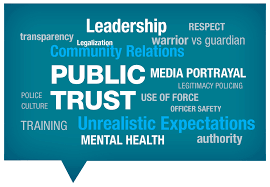Introduction

Community policing in the USA refers to a law enforcement strategy that emphasizes building strong relationships and partnerships between police departments and the communities they serve. It focuses on collaborative efforts to address crime and disorder, as well as improving the overall quality of life in neighborhoods.
Key principles of community policing include:
Partnerships:
Police work closely with community members, local organizations, businesses, and government agencies to identify and solve problems.
Problem-solving:
Rather than just responding to incidents, police and community members work together to identify underlying issues and develop strategies to address them.
Community Engagement:
Police departments engage in regular dialogue with residents through meetings, forums, and other events to build trust and address concerns.
Prevention:
Community policing emphasizes proactive measures to prevent crime and disorder, such as implementing crime prevention programs and focusing on early intervention.
Decentralized Decision Making:
Officers are given the autonomy to make decisions and tailor responses to the specific needs of their communities.
Accountability and Transparency:
Police departments strive to be accountable to the communities they serve by being transparent about their actions and decisions.
Community policing gained prominence in the 1980s and 1990s as a response to the limitations of traditional, reactive policing methods. Advocates argue that it fosters mutual respect between police and community members, improves public safety, and promotes a sense of ownership and responsibility among residents for the well-being of their neighborhoods.

However, effective implementation of community policing requires ongoing commitment from both law enforcement agencies and community stakeholders. Challenges can arise, including resource constraints, resistance to change within police departments, and skepticism from community members who may have historically strained relationships with law enforcement. Despite these challenges, many police departments across the United States continue to embrace community policing as a central tenet of their approach to maintaining public safety and promoting positive community relations.
Community policing in the United States represents a fundamental shift in law enforcement strategy, emphasizing collaboration, problem-solving, and relationship-building between police departments and the communities they serve. Originating as a response to the limitations of traditional policing methods, community policing has evolved into a comprehensive approach aimed at improving public safety and enhancing the quality of life in neighborhoods across the country. This essay explores the principles, strategies, challenges, and successes of community policing in the USA, highlighting its significance in fostering trust, collaboration, and safety.
Historical Context
The roots of community policing in the USA can be traced back to the 1960s and 1970s when law enforcement agencies began to recognize the need for a more proactive and community-oriented approach to policing. The civil rights movement, urban unrest, and growing distrust of law enforcement highlighted the limitations of traditional, reactive policing methods. In response, innovative police leaders and researchers began to develop new strategies focused on building partnerships with communities to address crime and social disorder.
Key Principles of Community Policing
At its core, community policing is guided by several key principles:
Partnerships
: Community policing emphasizes collaboration between police departments, residents, local organizations, businesses, and government agencies. By working together, stakeholders can identify shared goals, allocate resources effectively, and develop tailored solutions to address local concerns.
Problem-Solving
Rather than solely relying on enforcement tactics, community policing encourages a problem-solving approach. Police officers and community members work together to identify underlying issues contributing to crime and disorder, develop strategies to address them, and measure the effectiveness of interventions.
Community Engagement

Building trust and rapport with residents is essential for the success of community policing efforts. Police departments engage in regular dialogue with community members through meetings, forums, neighborhood patrols, and community events to listen to concerns, provide information, and solicit feedback.
Prevention
Community policing prioritizes proactive measures to prevent crime and enhance public safety. This includes implementing crime prevention programs, conducting environmental assessments to identify risk factors, and focusing on early intervention to address emerging issues before they escalate.
Decentralized Decision-Making
Community policing empowers police officers to make decisions and take action based on the specific needs and priorities of their communities. This decentralized approach allows for greater flexibility, responsiveness, and accountability at the local level.
Accountability and Transparency

Police departments are accountable to the communities they serve. Transparency about policies, procedures, and outcomes is essential for building trust and maintaining legitimacy. Community input and oversight mechanisms help ensure that police actions align with community expectations and values.
Strategies and Implementation
Implementing community policing requires a multifaceted approach that integrates various strategies and tactics:
Community-Oriented Policing
Police departments establish specialized units or assign officers to specific neighborhoods to build relationships, address concerns, and collaborate on problem-solving initiatives. These officers often serve as liaisons between the police department and the community, facilitating communication and partnership-building efforts.
Problem-Oriented Policing:
This strategy focuses on identifying and addressing the underlying causes of crime and disorder through data analysis, environmental assessments, and targeted interventions. Police departments work closely with other agencies, such as social services, housing authorities, and schools, to develop comprehensive solutions to complex problems.
Intelligence-Led Policing:
Community policing incorporates intelligence-gathering and analysis to identify emerging trends, hotspots, and criminal networks. By leveraging data and technology, police departments can allocate resources strategically, prioritize interventions, and respond effectively to changing community needs.
Procedural Justice:
Emphasizing fairness, respect, and transparency in police interactions is essential for building trust and legitimacy. Police departments train officers in communication skills, cultural competency, and de-escalation techniques to enhance the quality of interactions with community members.
Community Partnerships:
Police departments collaborate with a wide range of stakeholders, including local government agencies, nonprofit organizations, faith-based groups, businesses, and residents. These partnerships facilitate information-sharing, resource mobilization, and collective action to address community priorities.
Challenges and Criticisms

Despite its many benefits, community policing faces several challenges and criticisms:
- Resource Constraints: Implementing community policing requires significant investments in training, personnel, technology, and community outreach. Budgetary constraints and competing priorities may limit the capacity of police departments to fully embrace community-oriented strategies.
- Resistance to Change: Traditional policing cultures and organizational structures may resist efforts to adopt community-oriented approaches. Police officers and administrators may be skeptical of new paradigms, viewing them as a departure from traditional law enforcement practices.
- Trust Deficits: Historical tensions and systemic inequalities can erode trust between law enforcement agencies and marginalized communities. Rebuilding trust requires sustained efforts to address past injustices, acknowledge community grievances, and demonstrate a commitment to accountability and reform.
- Community Skepticism: Some community members may be skeptical of police intentions and reluctant to engage in collaborative efforts. Past negative experiences, perceptions of bias, and fear of reprisal can hinder meaningful dialogue and partnership-building.
- Sustainability: Community policing initiatives require ongoing commitment and support from both police departments and community stakeholders. Sustaining momentum and achieving long-term results may be challenging amidst changing political priorities, leadership turnover, and competing demands for resources.
Successes and Impact
Despite these challenges, community policing has demonstrated significant successes and positive impacts:
Crime Reduction
Research suggests that community policing can lead to reductions in crime and disorder by addressing underlying causes and mobilizing community resources. Collaborative problem-solving approaches have been associated with declines in violence, property crime, and social disorder in many communities.
Improved Police-Community Relations:
Community policing efforts have contributed to improved trust, communication, and cooperation between police departments and residents. Positive interactions, community engagement initiatives, and transparency measures have helped bridge divides and foster mutual respect.
Enhanced Quality of Life
By addressing neighborhood concerns and improving public safety, community policing contributes to a better quality of life for residents. Safer streets, cleaner parks, and stronger social connections create environments where residents feel empowered and invested in their communities.
Prevention and Early Intervention

: Community policing emphasizes proactive measures to prevent crime and address social problems before they escalate. Early intervention programs, youth engagement initiatives, and community partnerships help divert individuals away from criminal behavior and towards positive pathways.
Building Resilient Communities
: Community policing fosters resilience by strengthening social bonds, fostering civic engagement, and mobilizing collective action. Communities that actively participate in problem-solving and decision-making processes are better equipped to address challenges and adapt to changing circumstances.
Conclusion
Community policing represents a transformative approach to law enforcement that prioritizes collaboration, problem-solving, and relationship-building. By engaging with communities as partners, rather than just enforcers, police departments can enhance public safety, improve trust, and promote social justice. While challenges remain, the successes of community policing in the USA demonstrate its potential to create safer, healthier, and more resilient communities for all.



